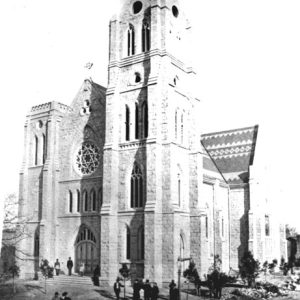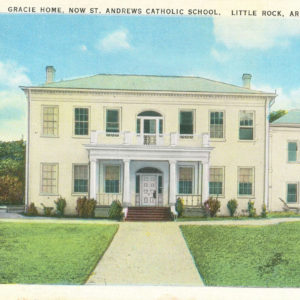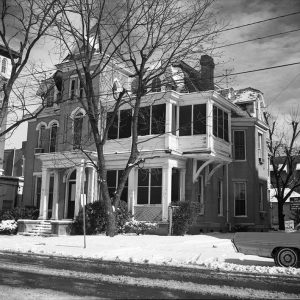calsfoundation@cals.org
Cathedral of St. Andrew
aka: St. Andrew's Catholic Cathedral
The Cathedral of St. Andrew is the oldest continuing place of worship in Little Rock (Pulaski County). It was dedicated in 1881 by Bishop Edward Fitzgerald, the second bishop of the Roman Catholic Diocese of Little Rock. Built in Gothic Revival style, the Cathedral of St. Andrew is made of rusticated granite mined from the Fourche Mountains, the northern section of the Ouachita Mountains. The structure, which was designed by architect Thomas Harding, is located at 617 South Louisiana Street, between 6th and 7th streets. Seating a maximum of 450, it is a comparatively small Catholic cathedral. The bell tower contains a 3,400-pound bell, the heaviest in Pulaski County. The bell tower stands 231 feet tall and was completed in 1887. The cathedral is the seat of the bishop of Little Rock; deceased bishops are buried in a crypt below the church. The cathedral’s first rector was Father Patrick Reilly.
In addition to the completion of the bell tower after the official dedication, many interior elements were also added or adjusted at a later date. The Stations of the Cross, for example, were built by German American sculptor Joseph Sibbel. The stations begin on the northern façade and end on the southern façade. Sibbel intended the sculptures to go to Holy Name Cathedral in Chicago, Illinois, but after their inadvertent delivery to Little Rock and installation there, the Archdiocese of Chicago gave them to St. Andrew’s. During the 1970s, as part of a broader reform of Catholic liturgical practices, Bishop Andrew McDonald added an altar that aided priests leading liturgies while facing the congregation. In 2004, Becky Witsell, a Little Rock restoration expert, began to stencil the original colors and patterns of the interior walls. The roof of the building was also repaired during the 2000s.
The Cathedral of St. Andrew was not the first Catholic cathedral in the state. Bishop Andrew Byrne had built a cathedral at 2nd and Center in 1845, two years after the Diocese of Little Rock was created. This property was sold and became the location of the Southern Trust Company Building, Little Rock’s first skyscraper; it is now known as Pyramid Place.
The Cathedral of St. Andrew’s has contributed to Catholic education in Arkansas. The Sisters of Mercy operated a school, across Louisiana Street from the current cathedral, at the invitation of Bishop Andrew Byrne. This institution became Mount St. Mary Academy, which relocated in 1908 to Pulaski Heights (Pulaski County). The parochial school continued to operate, run by Olivetan Benedictine sisters from Holy Angels Convent in Jonesboro (Craighead County). In 1923, Bishop John Morris purchased land on East 6th Street in order to expand the Cathedral School further. The Absalom Fowler House was built between 1838 and 1840 on that land. The cathedral parish owned the Fowler House until the 1970s and operated a school there until 1961.
The cathedral was added to the National Register of Historic Places on November 13, 1986.
For additional information:
Cathedral of St. Andrew. http://www.cathedralsaintandrew.org/ (accessed November 23, 2020).
Cathedral of St. Andrew Archive. McDonald Hall. Cathedral of St. Andrew, Little Rock, Arkansas.
“Cathedral’s Gothic Beauty Being Retained.” The Guardian, June 13, 1975, pp. 1–2.
Little, Tara. “Cathedral Stenciling Is a Wonder to Behold.” Arkansas Catholic, December 23, 2006. Online at http://www.arkansas-catholic.org/news/article/736 (accessed November 23, 2020).
“St. Andrew’s Cathedral.” The Guardian, December 20, 1924, p. 8.
“St. Andrew’s Catholic Cathedral.” National Register of Historic Places nomination form. On file at Arkansas Historic Preservation Program, Little Rock, Arkansas. Online at http://www.arkansaspreservation.com/National-Register-Listings/PDF/PU0244.nr.pdf (accessed November 23, 2020).
Woods, James M. Mission and Memory: A History of the Catholic Church in Arkansas. Little Rock: August House Publishing Co., 1993.
Josh Hart
Little Rock, Arkansas
 Historic Preservation
Historic Preservation Post-Reconstruction through the Gilded Age, 1875 through 1900
Post-Reconstruction through the Gilded Age, 1875 through 1900 Religion
Religion Cathedral of St. Andrew
Cathedral of St. Andrew  Cathedral of St. Andrew
Cathedral of St. Andrew  Fowler House
Fowler House  Gracie Home
Gracie Home  St. Andrew Rectory
St. Andrew Rectory 




Comments
No comments on this entry yet.